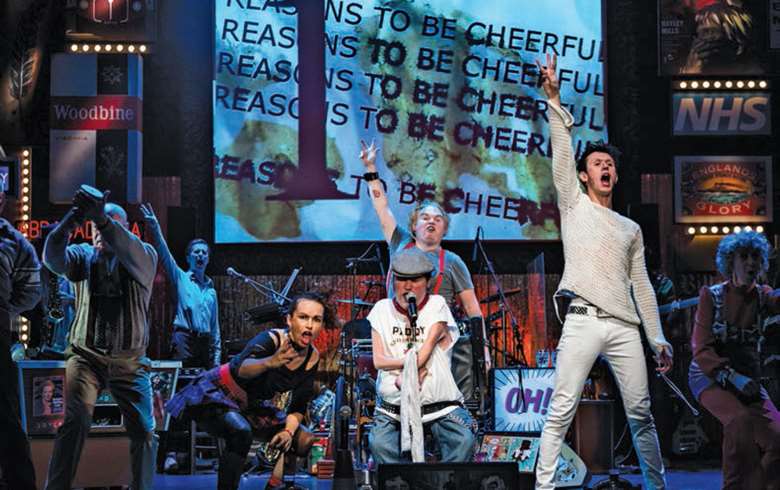Practitioner Focus: Graeae
Robert Marsden
Sunday, December 1, 2019
Robert Marsden turns the spotlight on a theatre company founded to undermine misconceptions about disability

PATRICK BALDWIN
Background
Graeae was founded in 1980 by Nabil Shaban and Richard Tomlinson, with the initial aim of undermining misconceptions surrounding disability through performance and training.
Current artistic director, Jenny Sealey, explains the genesis of the company's name from the ‘three Graeae sisters who were related to the Gorgons and had one eye [and one tooth] between them’. Having one eye and one tooth between three encompasses notions of sharing and of compromise, some of the key features of Graeae's work and their rehearsal processes.
Describing themselves as ‘led by D/deaf and disabled people pioneering a new inclusive dramatic language’, Graeae's work now tours internationally, ensuring disabled and D/deaf actors are integral storytellers.
Key features
Access
This is built into the productions themselves and threads into the dramaturgy in a variety of ways whereby sign language, captioning and audio-description (either from the actors and/or the audio-describer) are woven into the piece. When Graeae produced Sarah Kane's Blasted (2006 and 2019), the bracketed ‘unspoken’ lines of action became natural audio-descriptive lines. Layers of different languages therefore open up narrative possibilities in a Graeae production of a text.
Learning company
Learning is at the heart of the company, both in relation to self-reflection and evaluation. Graeae's Ensemble training company, for example, explore theatre making with D/deaf and disabled artists.
Work in progress
The company continues to evolve in relation to access and challenging normative ways of theatre making and storytelling. Current areas of exploration include gender identity and neurodiversity, as well as work with and for deafblind artists and audiences.
Influences
A driving force for their work is to ensure that the rehearsal process is as democratic and inclusive as possible. Sealey's rehearsal process is to create an ensemble and rehearsal actively and somatically, as opposed to cerebrally, such as sitting around a table actioning lines with transitive verbs:
‘I give a lot of power to the artists. I like to play, then we find out the intentions working through it. It's a deaf thing, my stimulus is visual – the pictures, the body language. That's when I get excited and can see the story […]. I run a rehearsal room based on trust, people have to get on with what they need to do.’
Exercise 1: Sign names
Sign names is the first exercise with which Sealey begins every workshop and rehearsal process. Each student creates their own sign name which everybody else copies. Ideally standing in a circle, the first student creates their own sign name by finding the appropriate audio-descriptive language after visualising their sign name in their mind's eye. They then give out the instructions of how to do this and everyone copies.
Sign names might describe the student's personality, be a signifier for a physical characteristic, their job or favourite hobby. As this is signed, the student states their name, such as ‘Rob’ and all other students repeat this. Through this exercise and Zip-Zap Boing!, students are introduced to the two core exercises of a Graeae rehearsal period. See links below for more information on sign names.
Exercise 2: Zip-Zap-Boing!
For a group of all sighted, all non-disabled students, the game is played with the aim of understanding and embodying access needs. Students go back to back, so they are unable to see each other and therefore consensual touch becomes a way to communicate and if a student ‘zaps’ behind them, they need to say the name of the other person. If there are blind students, then adaptations are made with touch and sound.
The game has been adapted by Graeae's Ensemble company to include ‘in the middle' whereby students can express their worries, for example, becoming a place to check-in without it feeling explicit or overwhelming.
Aim to create your own rules for this game, placing access and individual needs at the heart of your decision making.
Exercise 3: Audio description of self
Students begin with an audio description of themselves: ‘I'm Rob, I'm five foot ten, Caucasian…’ If you define as D/disabled then this is added to your audio descriptive narrative before moving on to audio describe the character, ‘I'm Hamlet, I'm 28 and live in Elsinore…I am wearing…’ This enables each student actor to think about their themselves and their character from a physical point of view, as well as the characteristics and qualities of their character. This allows students to describe themselves as they wish to be described and begin to embody their character's qualities and outer characteristics.
Resources
Graeae website: www.graeae.org
Book: Reasons to be Graeae: a work in progress is edited by Jenny Sealey and published by Oberon Books (2018)
Information on Sign Names: http://www.bbc.co.uk/ouch/features/sign_names.shtml

